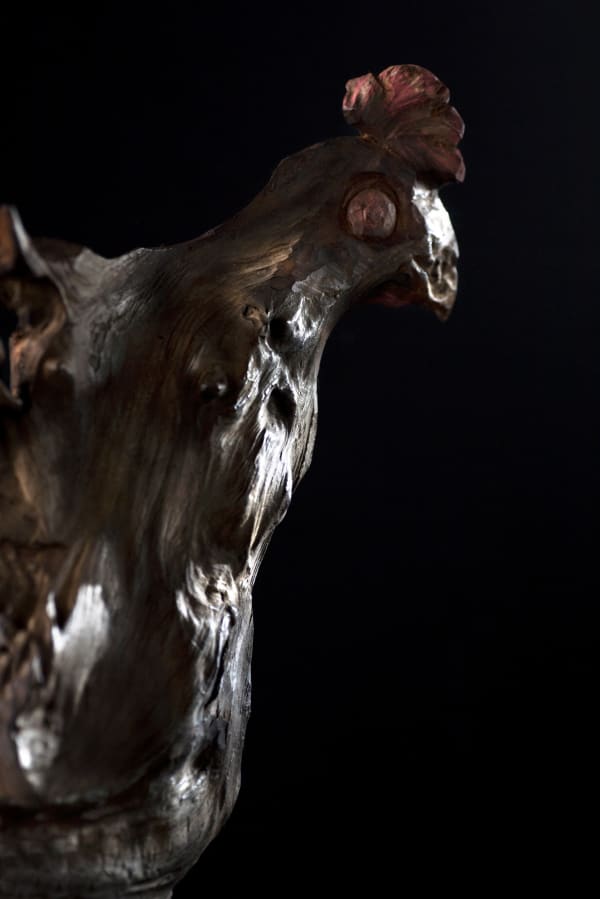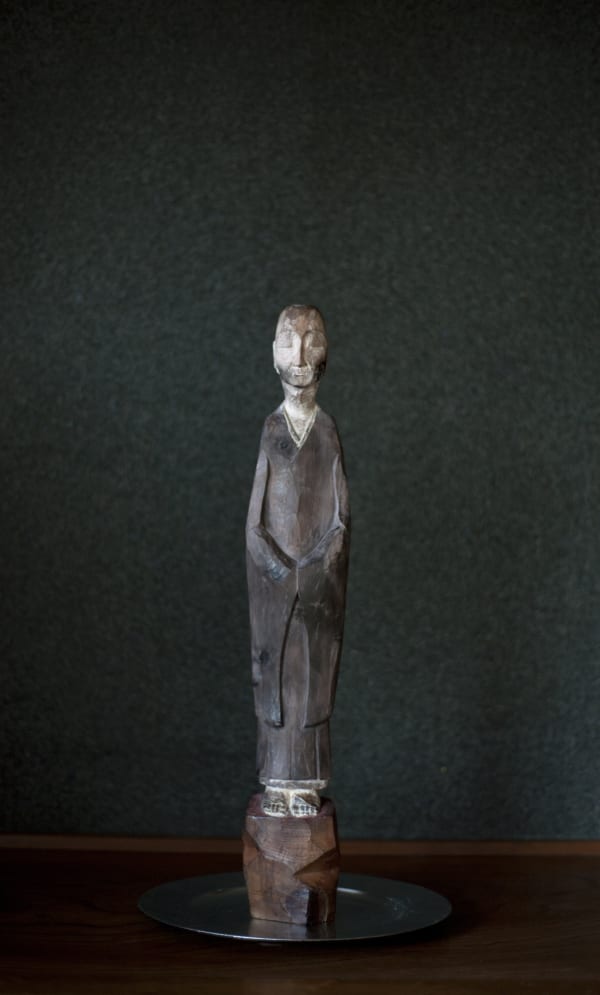Sculpting ‘Emptiness’: Wood sculptures by Sho Kishino
An Artist Who Sculpts ‘Emptiness’
Shoko Aono
Shō Kishino’s sculptures depict the ‘emptiness’ that envelops them. Although they may take the form of a human figure, an animal or a priest, by paring away all superfluous material, he manages to accentuate their inner spirit. He works in wood—old wood from temples or shrines, wood that he discovers on riverbanks or mountains, cherry or zelkova, branches of bog cedar, plum bark, mulberry roots, or fossilized wood that has been dug out of riverbeds. The shapes he creates bringing out the life force that exists within it. Visiting the temples in his hometown of Kyoto, he became friendly with the priests and strove to discover the spirit of Zen, while in his youth he also studied Western-style painting and bronze sculpture, identifying with the artistic expression of the Swiss artist, Alberto Giacometti (1901-1966). Kishino says, ‘Japanese sculpture does not consist of adding and modeling material into the desired shape, rather it is a subtractive art, resulting from the space that is born through the removal of the material.’ His subjects are pared down to an extreme degree, making them infinitely open to the outer world. Once everything has been discarded, the resulting emptiness presents the true essence of existence. This is the sorrow and compassion of humankind. It is what fills the world with vibrations of beauty that are transmitted directly to the soul of the viewer.
Born in Kyoto in 1972, Shō Kishino’s father was a Suiboku (ink wash painting) artist and his mother, a potter. He was raised with a strong awareness of Japanese history and creative culture, although when he was young he studied under a Western-style painter and it was at this time that he became influenced by the worldview of Alberto Giacometti, which is ‘to depict the visible as it appears.’ Adhering strictly to this, negating the subject’s components and outline, Giacometti was able to evoke its true essence, a way of thinking demonstrating an aspiration towards far-eastern awareness. Contemplating the differences that exist between the Eastern and Western methods of looking at things, Kishino realized that Japanese sculpture was not concerned solely with form, but rather placed greater importance on the object’s internal/external space. This led him to use wood as his material- a material that can be gradually shaved away. He is a regular visitor to Ryūkōin Temple in the Daitokuji Temple complex, and meeting the chief priest, he gradually realized his own insignificance. From that time forward, sculpting became a form of spiritual training through which he sought self-improvement. He devoted himself to finding his true nature through his art, honing his spirit as he carved his sculptures, cut by cut. This can be said to resemble the Japanese art of calligraphy in which a brush is used to apply the ink, stroke by stroke, while focusing the mind to complete each character. A 17th century itinerant priest, named Enkū (1632-1695) is famous for his carvings of dynamic Buddhist images that he created from scraps of wood, and Shō Kishino’s can be said to be a contemporary counterpart of his for the way in which he imbues the wood with existence. Beyond this existence, a new landscape will extend into infinity.
Ippodo Gallery New York is delighted to announce it will be holding the first ever exhibition of Shō Kishino’s work outside Japan from September 12 to October 3, 2013. The exhibition is on view by appointment only.
Shō Kishino’s sculptures depict the ‘emptiness’ that envelops them. Although they may take the form of a human figure, an animal or a priest, by paring away all superfluous material, he manages to accentuate their inner spirit. He works in wood—old wood from temples or shrines, wood that he discovers on riverbanks or mountains, cherry or zelkova, branches of bog cedar, plum bark, mulberry roots, or fossilized wood that has been dug out of riverbeds. The shapes he creates bringing out the life force that exists within it. Visiting the temples in his hometown of Kyoto, he became friendly with the priests and strove to discover the spirit of Zen, while in his youth he also studied Western-style painting and bronze sculpture, identifying with the artistic expression of the Swiss artist, Alberto Giacometti (1901-1966). Kishino says, ‘Japanese sculpture does not consist of adding and modeling material into the desired shape, rather it is a subtractive art, resulting from the space that is born through the removal of the material.’ His subjects are pared down to an extreme degree, making them infinitely open to the outer world. Once everything has been discarded, the resulting emptiness presents the true essence of existence. This is the sorrow and compassion of humankind. It is what fills the world with vibrations of beauty that are transmitted directly to the soul of the viewer.
This exhibition will consist of selected works, including: ‘Novice Priest’, ‘Laugh’, ‘Rakan (Arhat)’, ‘Mother’, ‘Shamo (Japanese Gamecock)’, ‘Priest’. ‘Walk’, etc.
Born in Kyoto in 1972, Shō Kishino’s father was a Suiboku (ink wash painting) artist and his mother, a potter. He was raised with a strong awareness of Japanese history and creative culture, although when he was young he studied under a Western-style painter and it was at this time that he became influenced by the worldview of Alberto Giacometti, which is ‘to depict the visible as it appears.’ Adhering strictly to this, negating the subject’s components and outline, Giacometti was able to evoke its true essence, a way of thinking demonstrating an aspiration towards far-eastern awareness. Contemplating the differences that exist between the Eastern and Western methods of looking at things, Kishino realized that Japanese sculpture was not concerned solely with form, but rather placed greater importance on the object’s internal/external space. This led him to use wood as his material- a material that can be gradually shaved away. He is a regular visitor to Ryūkōin Temple in the Daitokuji Temple complex, and meeting the chief priest, he gradually realized his own insignificance. From that time forward, sculpting became a form of spiritual training through which he sought self-improvement. He devoted himself to finding his true nature through his art, honing his spirit as he carved his sculptures, cut by cut. This can be said to resemble the Japanese art of calligraphy in which a brush is used to apply the ink, stroke by stroke, while focusing the mind to complete each character. A 17th century itinerant priest, named Enkū (1632-1695) is famous for his carvings of dynamic Buddhist images that he created from scraps of wood, and Shō Kishino’s can be said to be a contemporary counterpart of his for the way in which he imbues the wood with existence. Beyond this existence, a new landscape will extend into infinity.











